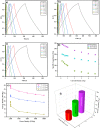High-performance hybrid supercapacitor-immobilized Wells-Dawson polyoxometalates on activated carbon electrodes
- PMID: 37681037
- PMCID: PMC10481258
- DOI: 10.1039/d3ra04478e
High-performance hybrid supercapacitor-immobilized Wells-Dawson polyoxometalates on activated carbon electrodes
Abstract
The nanofabrication of electroactive hybrid materials for next-generation energy storage devices is becoming increasingly significant as supercapacitor (SC) technology develops rapidly. The present study utilizes activated carbon (AC) templates reinforced with Wells-Dawson polyoxotungstates (POMs) to produce nanohybrid electrodes for high-performance supercapacitors. This study analyzes Wells-Dawson polyoxotungstates (P2W18) for the first time integrated with AC, and its structural and electrochemical performances are discussed. First, the electrochemical performances of symmetric supercapacitors were characterized in an acidic aqueous electrolyte (0.5 M H2SO4). It was observed that a supercapacitor cell containing the 5 wt% AC-P2W18 hybrid symmetric displayed a noteworthy specific capacitance of 289 F g-1 and a remarkable energy density of 40 W h kg-1. Moreover, 5% AC-P2W18 symmetric supercapacitor cells showed 89% cyclic stability over 4000 cycles. Three LED lights were charged onto the electrode. The LEDs continued to illuminate continuously for red until 160 seconds, yellow until 20 seconds, and blue until 10 seconds after removing the electrode from the electrochemical workstation, demonstrating the device's power and energy density.
This journal is © The Royal Society of Chemistry.
Conflict of interest statement
The authors declare that they have no known competing financial interests or personal relationships that could have appeared to influence the work reported in this paper.
Figures









References
-
- Vangari M. Pryor T. Jiang L. Supercapacitors: Review of Materials and Fabrication Methods. J. Energy Eng. 2013;139(2):72–79. doi: 10.1061/(ASCE)EY.1943-7897.0000102. - DOI
-
- González A. Goikolea E. Barrena J. A. Mysyk R. Review on Supercapacitors: Technologies and Materials. Renewable Sustainable Energy Rev. 2016;58:1189–1206. doi: 10.1016/j.rser.2015.12.249. - DOI
-
- Bandhauer T. M. Garimella S. Fuller T. F. A Critical Review of Thermal Issues in Lithium-Ion Batteries. J. Electrochem. Soc. 2011;158(3):R1. doi: 10.1149/1.3515880. - DOI
-
- Conte M. Supercapacitors Technical Requirements for New Applications. Fuel Cells. 2010;10(5):806–818. doi: 10.1002/fuce.201000087. - DOI
LinkOut - more resources
Full Text Sources

